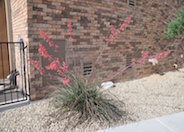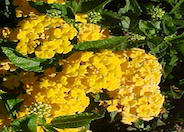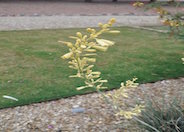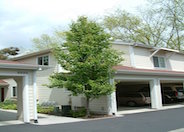
Common name:Bi-colored Hesperaloe
Botanical name:Hesperaloe parviflora 'Duet'
Spectacular accent for desert gardens anywhere. Plants tolerate drought, full sun, reflected heat, and poor soils. Forms rosettes of leaves 4' x 6'. The red and yellow flower stalks emerge in spring and remain on the plant until the end of summer. - Mountain States Nursery

Common name:Trailing Lantana
Botanical name:Lantana hybrid 'New Gold'
Evergreen groundcover forms a dark green mound 18" x 3'. Another reliable bloomer on and off throughout the year. Provides wonderful golden flowers, and benefits from deep, infrequent watering and some pruning. Attracts butterflies. May suffer some frost damage but will recover quickly. Very root hardy.

Common name:Hesperaloe Yellow
Botanical name:Hesperaloe parviflora 'Yellow'
Upright succulent grows quickly to 3' x 5'. The yellow flower stalks emerge in spring and remain on the plant until the end of summer. Dark green strappy leaves. Plants tolerate drought, full sun, reflected heat, poor soils, and frost.

Common name:Bradford Callery Pear
Botanical name:Pyrus calleryana 'Bradford'
The 'Bradford' is a deciduous tree that grows to a size of 25'-30'. Profuse clusters of single white flowers are borne in the spring from noticeably sweeping branches.

Common name:Blue Euphorbia
Botanical name:Euphorbia rigida
Evergreen mounding groundcover grows at a slow-moderate to 2' x 3'. The charteuse flowers appear midwinter through spring and add a nice contrast to the blue-green leaves. This plant truly has striking flowers and floliage. Low maintainance. Sap from plant may irrigate skin. Native to the Mediterranean.
Designer: Jennifer Barr
Photographer: GardenSoft
Incorporate compost 6" into your soil to retain water, reduce compaction, feed earthworms, and provide valuable nutrients to your plants.
Different areas of your landscape have different water requirements.
Shrubs need much less water than lawns and drip systems should never be scheduled on the same program with lawns.
Establish separate watering schedules for those areas.
Remove irrigation water and fertilizer from areas where you don't want weeds to grow.